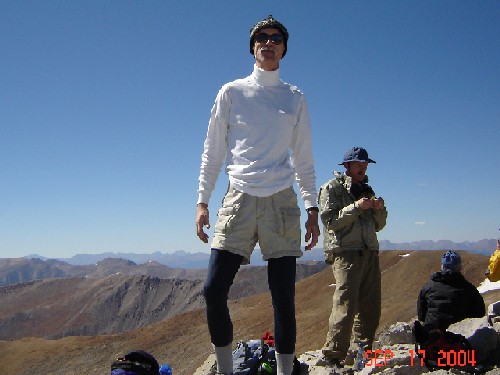
Even though we left home at
However, we did not take the shortest road route to the trailhead, and that was just the first of several miscues which lengthened our day.
Setting off with the sun already well up, we ventured into the western reaches of the Maroon Bells-Snowmass Wilderness area. With all the snow the area got this year, it is wet and lush, and plant life (including but not limited to wildflowers) is going great guns. The beautiful trail which leads up past Geneva Lake and to the west side of Snowmass, although well-trodden, and clear at close quarters, can hardly be seen from any significant distance. We also marveled at the abundance of waterfalls and cascades on every slope ringing the basin.
Despite the late start, the day started off well enough. Less than three hours brought us up to about 12,000 ft just west of our target mountain. We had done two-thirds of the distance, and half the altitude gain, to the summit. We surveyed the handful of rocky gullies which punctuate Snowmass’ west face, and finally decided that the northernmost one offered the easiest path to the summit ridge. The others all sported running water, or sections where tilted slabs of rock, offering little in the way of handholds or ledges to support feet, would have to be crossed. So, after giving up a little altitude to cross the valley of Lost Trail Creek (which drains out of Siberia Lake just to the north), we got out our ice axes, donned our helmets, and began the 2,000-foot rock climb to the top.
It was slow going right from the start.
There were still patches of snow, mostly in lanes down the middle of the gullies, but most of the mountain has completely melted out. For this reason, we decided to leave our crampons in our packs, and avoid the snow, sticking to the bare rocks instead. The trick was to find the easiest—and safest—path through the rocks, which vary greatly in size, and not all of which are really stable. Thus, we zig-zagged our way up the gully, sometimes on the left, sometimes on the right, sometimes on fields of small rocks which offered small steps at the expense of looseness, sometimes in real boulder fields which tended to be more stable, but required occasional gigantic steps.
As we climbed, we also increasingly found that the boulder fields required exposed moves. Trying to hold the difficulty level to the reputed Class 3 of this route proved, ultimately to be impossible.
Finally, well into the afternoon, with the top of the summit ridge apparently just a short distance above us, we made what may have been the biggest mistake of the day. Trying to avoid the loose scree which filled the center of our gully, we began moving out of it to the north, on large but stable boulders, trying to attain the ridge crest farther north than had originally been our intention. Almost without realizing it, we wound our way around clockwise to a position below the north end of the ridge. Our further pursuit of the line of least resistance then led us even further around, onto the east face of the upper part of the mountain, from which point we finally made our bid for the ridge.
We made it, but were dismayed to fine multiple ridge points—all spiky and built of very large boulders—still separating us from the true summit. There was nothing for it but to undertake a long traverse at or near to the crest. This was no small task, for all that the net distance was only a couple of hundred yards. The ridge is appalling narrow. Thus, each ridge point presented only two options: a very steep climb up one side and down the other, inevitably involving serious exposure and large steps, or a circuitous traverse on one side or the other, which also involved exposure, just in a sideways direction.
Naturally, we did finally make it—finally! It was, almost incredibly, nearly
We took only minimal pictures, despite the incredible views to be had. I did get one good shot of the Maroon Bells and
This did make getting off the summit block proper a good deal easier than reaching it had been. But we still faced hundreds and hundreds of feet of steep rock, of varying quality. Still using our ice axes for added stability, we went down as fast as we reasonably could, since rain was clearly threatening.
In fact, rain mixed with grapple did fall on us in several little spurts before we could clear the rock slopes. Fortunately, it never set in in earnest, but it did make the rocks a bit slippery—slowing us down even more—for a while.
Only four other people signed the
Even though we didn’t get back to the trailhead until after dark, it was still a satisfying day. All I can say is, this is a harder mountain than it’s usually cracked up to be, and we are both glad to be able to say we’ve done it!
Pictures are at:
http://www.imagestation.com/album/pictures.html?id=2090026704
or
http://www.picasaweb.google.com/tcogwr/SnowmassMountain
Long life and many peaks!


0 Comments:
Post a Comment
<< Home